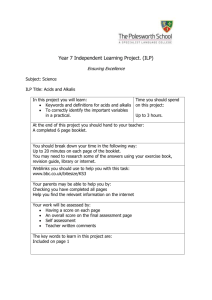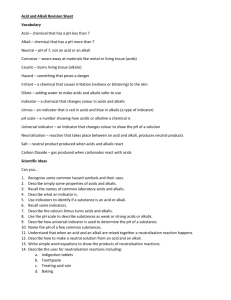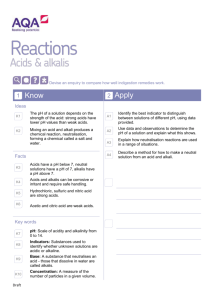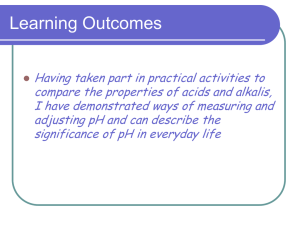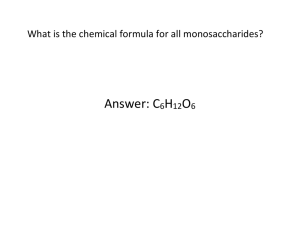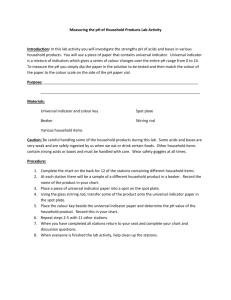Acids and alkalis: Improving practical work
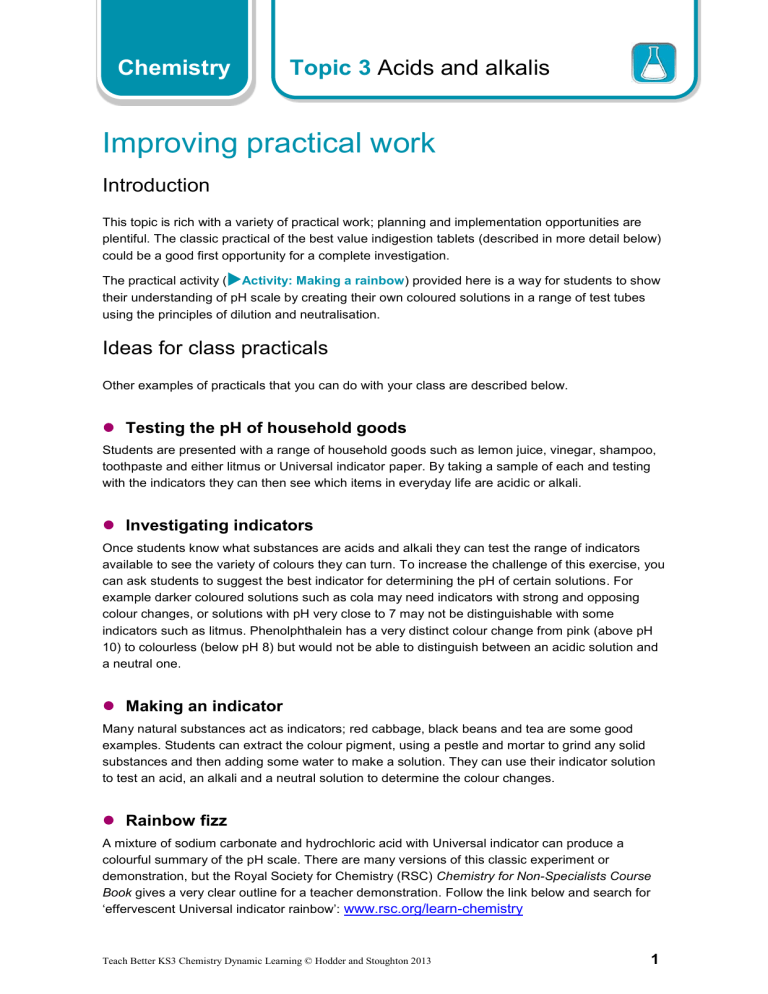
Chemistry Topic 3 Acids and alkalis
Improving practical work
Introduction
This topic is rich with a variety of practical work; planning and implementation opportunities are plentiful. The classic practical of the best value indigestion tablets (described in more detail below) could be a good first opportunity for a complete investigation.
The practical activity (
Activity: Making a rainbow ) provided here is a way for students to show their understanding of pH scale by creating their own coloured solutions in a range of test tubes using the principles of dilution and neutralisation.
Ideas for class practicals
Other examples of practicals that you can do with your class are described below.
Testing the pH of household goods
Students are presented with a range of household goods such as lemon juice, vinegar, shampoo, toothpaste and either litmus or Universal indicator paper. By taking a sample of each and testing with the indicators they can then see which items in everyday life are acidic or alkali.
Investigating indicators
Once students know what substances are acids and alkali they can test the range of indicators available to see the variety of colours they can turn. To increase the challenge of this exercise, you can ask students to suggest the best indicator for determining the pH of certain solutions. For example darker coloured solutions such as cola may need indicators with strong and opposing colour changes, or solutions with pH very close to 7 may not be distinguishable with some indicators such as litmus. Phenolphthalein has a very distinct colour change from pink (above pH
10) to colourless (below pH 8) but would not be able to distinguish between an acidic solution and a neutral one.
Making an indicator
Many natural substances act as indicators; red cabbage, black beans and tea are some good examples. Students can extract the colour pigment, using a pestle and mortar to grind any solid substances and then adding some water to make a solution. They can use their indicator solution to test an acid, an alkali and a neutral solution to determine the colour changes.
Rainbow fizz
A mixture of sodium carbonate and hydrochloric acid with Universal indicator can produce a colourful summary of the pH scale. There are many versions of this classic experiment or demonstration, but the Royal Society for Chemistry (RSC) Chemistry for Non-Specialists Course
Book gives a very clear outline for a teacher demonstration. Follow the link below and search for
‘effervescent Universal indicator rainbow’:
www.rsc.org/learn-chemistry
Teach Better KS3 Chemistry Dynamic Learning © Hodder and Stoughton 2013 1
Chemistry • Topic 3 • Acids and alkalis
Best value indigestion tablets
Indigestion tablets have many active ingredients. The most common are a range of carbonates, with the intention that these will neutralise excess stomach acid. The neutralising power of indigestion tablets can be investigated by measuring the volume of HCl needed to take the pH to
7. Students should crush the tablets, find their mass and, after adding Universal indicator, add HCl drop wise until pH 7 is reached The volume of acid added is then used as a measure of the neutralising ability of the tablet. This can form the basis of a full investigation with comparisons to cost per gram used to determine best value.
Reactions with acids
Students can see first-hand the difference in reaction rate with various acids and concentrations.
Magnesium ribbon and calcium pieces are the best metals to choose and acids such as hydrochloric, sulfuric and ethanoic, in different concentrations, can be chosen. Observations relating to the time it takes for metal to completely react or the rate of bubble formation can provide experience in implementation and analysis.
Effects of acids on everyday items
This can be a demonstration set up over several days. Interesting samples to put in the acid include chicken bones, which will become flexible as the acid reacts with the calcium; eggs, which leads to the shell dissolving leaving the membrane encasing the raw egg; coins and many metal items such as badges will be cleaned by the acid, as will rusty nails.
Using pH meters
The same samples from the everyday testing can be used along with laboratory acids and alkalis.
Students simply place the pH meter into the sample to obtain a pH reading, which is often to one or more decimal places, indicating the increased sensitivity of the equipment. If you have the facilities to connect a pH meter to a data logger, an excellent demonstration of dilution is to project the graph formed of the change in pH as water is added.
Practical work in everyday teaching
Here are a few ideas to help you incorporate skills building for practical work into your everyday lessons on this topic.
Quick fire pH changes
These are practical starter activities.
1 Students receive samples of an acid in a test tube with Universal indicator solution. They have a selection of weak alkali solutions and water and the aim is to change the pH to 7 in a fixed amount of time.
2 Students receive two samples of acids and have to determine which acid is the most concentrated. Provide pieces of magnesium or samples of carbonate to be added and a range of indicators.
3 Students receive two everyday solutions and have to determine if they are acid, alkali or neutral using a specific indicator.
Teach Better KS3 Chemistry Dynamic Learning © Hodder and Stoughton 2013 2
Chemistry • Topic 3 • Acids and alkalis
Magnesium and acid reaction timer
This could add some fizz to the usual timing methods. The teacher sets up a beaker containing acid and starts the timer by dropping in a set amount of magnesium. Students have until the metal reacts to clear up or complete an activity.
Mystery solutions
This would make a good plenary exercise.
Provide students with an unlabelled solution that is dark in colour. Possible solutions could be vinegar, cola or dark coloured bubble bath.
Have available a range of testing equipment: Universal indicator solution, labelled solutions of various acids and alkalis of various concentrations, magnesium pieces.
Students need to try and determine if the solution is acid, alkali or neutral and by how much without relying on colour change.
Hints and tips for students
They could try to dilute the samples to reduce the intensity of colour to where they can see the indicator – they would then have to scale back up from their dilution.
They could add magnesium and see if it reacts and how quickly and compare this to a known solution of known pH.
They could add a small amount of the unknown to the other solutions and see if it changes the pH of the known solution to deduce its nature.
Activity: Making a rainbow
Follow this link to a video of this practical:
Video: Making a rainbow .
The activity presents a practical challenge. It would serve well as a revision practical as it can draw on all the understanding from the topic. The challenge for students is to make a range of solutions that will show the characteristic colours of Universal indicator. The provision of an acid, an alkali and water allows student to apply their understanding of dilution and neutralisation.
The task can also be easily differentiated – students can create the colours by trial and error and be guided to reflect on how they achieved this.
To increase the challenge you could ask students to plan how they would create the colours, and then give time for implementation and refinement. For very high challenge you could limit the volumes of solutions available to 15 cm 3 of each solution and set a minimum depth for each tube.
Follow this link for the student worksheet:
Activity: Making a rainbow .
Answers to the activity
1 diluting, neutralising and reacting
2 Test tube 1: pH 1 –2; test tube 2: pH 3 –4; test tube 3: pH 5 –6; test tube 4: pH 7; test tube 5: pH
8 –10; test tube 6: pH 11 –14
3 Students could describe methods to dilute or further neutralise the samples either side or describe different volumes to add together in-between the ones they have used. Be wary of students who comment on adding less Universal indicator to get a paler colour, as this is not correct.
Teach Better KS3 Chemistry Dynamic Learning © Hodder and Stoughton 2013 3
Chemistry • Topic 3 • Acids and alkalis
Hazard assessment
0.1
M HCl – irritant
0.1
M NaOH – irritant
Universal indicator solution – flammable
Safety glasses to be worn
Technician notes
Equipment needed
For each pair – 5 test tubes, test tube rack, Universal indicator drop bottle
For the class – 0.1
M HCl, 0.1
M NaOH, water bottles or several sources of mains water, measuring cylinders, Pasteur pipettes
Procedure
The procedure is detailed on the student worksheet.
The methods will require a range of measuring, either using cylinders or Pasteur pipettes.
Students are looking to create some of the Universal indicator colours.
Teach Better KS3 Chemistry Dynamic Learning © Hodder and Stoughton 2013 4
